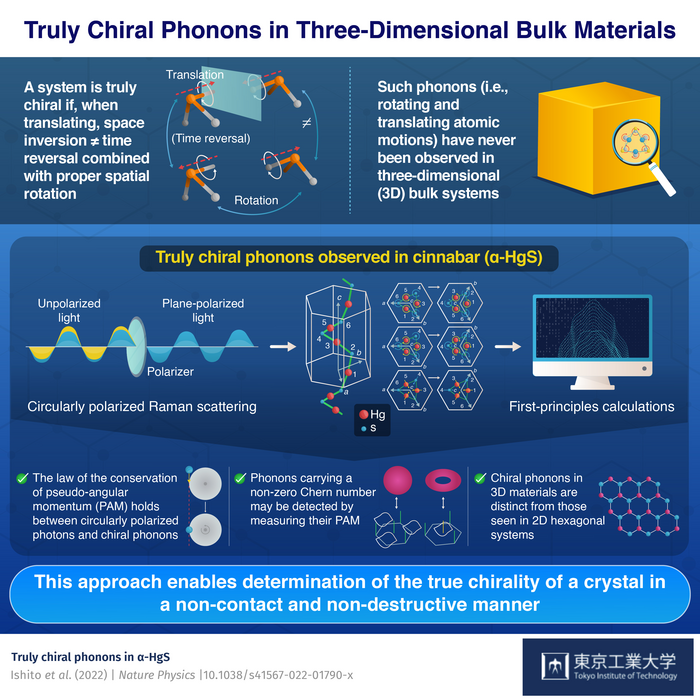Reviewed by Alex SmithNov 10 2022
The breakdown of the reflection and inversion symmetries is known as chirality. It occurs when an object’s mirror images cannot be superimposed on top of one another. Two hands of humans are a good example; even though they are mirror images of one another, they can never overlap. Chirality is pervasive and can be seen at all scales.
 Truly chiral phonons—i.e., rotating and propagating atomic motions seen in a crystal lattice—have never been observed in a bulk 3D material. However, now, Tokyo Tech researchers have identified these in cinnabar. Image Credit: Tokyo Tech
Truly chiral phonons—i.e., rotating and propagating atomic motions seen in a crystal lattice—have never been observed in a bulk 3D material. However, now, Tokyo Tech researchers have identified these in cinnabar. Image Credit: Tokyo Tech
Chirality can result from dynamic, rotation, and static motion. This allows for distinguishing between true and false chirality. If a system’s translation does not result in time reversal and a suitable spatial rotation, it is said to be truly chiral.
Quanta of energy known as phonons are linked to the vibration of atoms in a crystal lattice. Recently, chiral phonons with two dimensions (2D) have been theorized and experimentally identified in materials like tungsten diselenide.
The recently discovered chiral phonons are atomic motions that rotate but do not propagate. However, for the atomic motions to be truly chiral, they must rotate and propagate. Such motions have never been seen in three-dimensional (3D) bulk systems.
Now, theoretically and experimentally, a group of researchers led by academics from the Tokyo Institute of Technology (Tokyo Tech) has truly discovered chiral phonons. The group studied the chiral phonons in cinnabar (α-HgS) under the direction of Professor Takuya Satoh of the Tokyo Tech Department of Physics.
To accomplish this, a circularly polarized Raman scattering, an experimental method, and first-principles calculations were used.
Chiral structures can be probed using chiral techniques. So, using circularly polarized light, which has its own handedness (i.e., right-handed or left-handedness), is critical. Dynamic chiral structures can be mapped using pseudo-angular momentum (PAM). Pseudo-momentum and PAM originate from the phase factors acquired by discrete translation and rotation symmetry operations, respectively.
Takuya Satoh, Professor, Department of Physics, Tokyo Institute of Technology
The innovative experimental strategy used by the researchers enabled them to investigate the core characteristics of PAM. They discovered that one of the fundamental laws of physics, the conservation of PAM, holds between chiral phonons and circularly polarized photons.
Our work also provides an optical method to identify the handedness of chiral materials using PAM. Namely, we can determine the handedness of materials with better resolution than x-ray diffraction (XRD) can achieve. Moreover, XRD requires a large-enough crystal, is invasive, and can be destructive. Circularly polarized Raman scattering, on the other hand, allowed us to determine the chirality of structures XRD could not, in a non-contact and non-destructive manner.
Takuya Satoh, Professor, Department of Physics, Tokyo Institute of Technology
Truly chiral phonons, which are distinctly different from those previously observed in 2D hexagonal systems, are discovered for the first time in 3D materials in this study.
The knowledge gained here could serve as a springboard for new research into creating strategies for converting the PAM from photons to electron spins by propagating chiral phonons in subsequent devices.
Additionally, this method makes it possible to identify a crystal’s true chirality more accurately, giving investigators and researchers a vital new tool.
Journal Reference:
Ishito, K., et al. (2022) Truly chiral phonons in α-HgS. Nature Physics. doi:10.1038/s41567-022-01790-x.